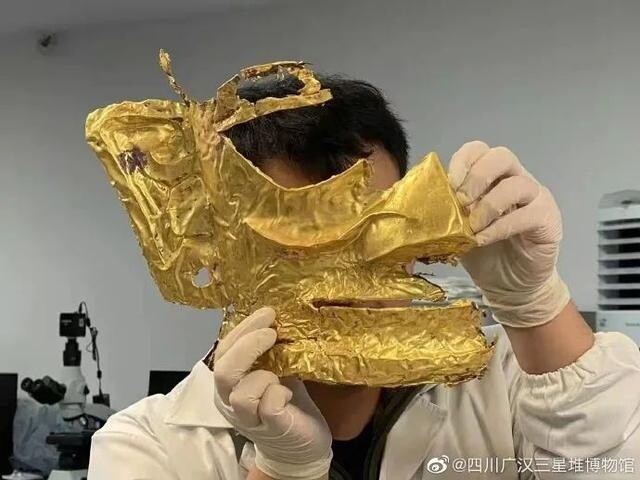San Xingdui ruins, gold, bronze, jade, etc.
History “Border” Sichuan is also an ancient civilization… Challenge the Jungwon-centered History Museum

A golden mask found thousands of years ago in Sichuan. yunhap news
A rare golden mask has been excavated from an ancient ruins in Sichuan Province, China, attracting extraordinary attention from academia. Sichuan Province, in southwestern China, was in ancient times an isolated area away from the birthplace of Chinese civilization, Zhongyuan. As highly elaborate artifacts were discovered in an area where there was an unknown civilization far from Jungwon, it is even observed that the ancient history of China in the center of Jungwon may be newly written. Chinese cultural heritage authorities held a briefing in Chengdu, Sichuan Province on the 20th, and as a result of a large-scale excavation, more than 500 artifacts, including golden masks, bronze ware, jade ware, and ivory ornaments, were located in six “ceremonial gangs” in the Sanxingdu ruins. Hong Kong South China Morning Post (SCMP) and Shin-Bo (新京報) reported on the 21st. Local media particularly noted the discovery of the golden mask, which is believed to have been made 3,000 years ago. This golden mask is in a relatively intact state, although part of the face has disappeared. The size of the golden mask is 23cm in width and 28cm in height, respectively, and weighs about 280g. The purity of gold was found to be about 84%. The excavation team estimated that if this golden mask had been intact, the total weight would have exceeded about 500 grams. Academia attaches great significance to the large number of highly elaborate relics, including golden masks that may have been worn by priests during religious ceremonies, at the Sanxingdui ruins, which are far from the mainstream of Chinese history. What is particularly eye-catching is that the Sanxingdui ruins remain a mystery area even in Chinese academia. The Sanxingdui ruins in Sichuan Province’s Guanghan City preserved the traces of the period spanning about 2,000 years from the Neolithic to the ancient Yin Dynasty, and the first excavations began in 1934. SCMP said, “The San Xingdui ruins remain the biggest mystery in the Chinese archaeological world. The artifacts found here have no remarkable connection to the later Chinese culture, and no one has ever deciphered the symbol of the artifact here. I introduced it. Sichuan Province is geographically separated by a mountain range and the Zhongyuan, which is considered to be the center of Chinese history. The area of Sichuan Province, where the Sanxingdui ruins are located, was fully incorporated into Chinese history after the conquest of the Qin Dynasty in 316 BC. SCMP said, “The treasures of the mysterious civilization can rewrite the history of China.” The newspaper pointed out that “the existence of an unknown civilization outside the center of the traditional Chinese civilization may mean that the Chinese civilization has roots formed by several peoples.” “For a long time, Zhongyuan has been the center of the most civilized world, and people living outside have been regarded as barbarians,” said Shi Jinsong, deputy director of the Archaeological Institute of the Chinese Academy of Social High Schools. However, the massive relics poured out of the Sanxingdui ruins show that the history of Chinese civilization can be far more complex than traditional ideas. However, China may also engage in academic work that embraces the newly illuminated San Xingdui culture as a part of its own history and culture. China is systematically continuing the work of actively including the history of minorities other than the Han Chinese, which is regarded as mainstream, as the history of China. Song Xinqiao, deputy director of the National Cultural Heritage Bureau, explained that the discovery of Sanxingdui relics, which is being carried out by the state, is being carried out as part of a national program to solve a major problem in China’s history. yunhap news
